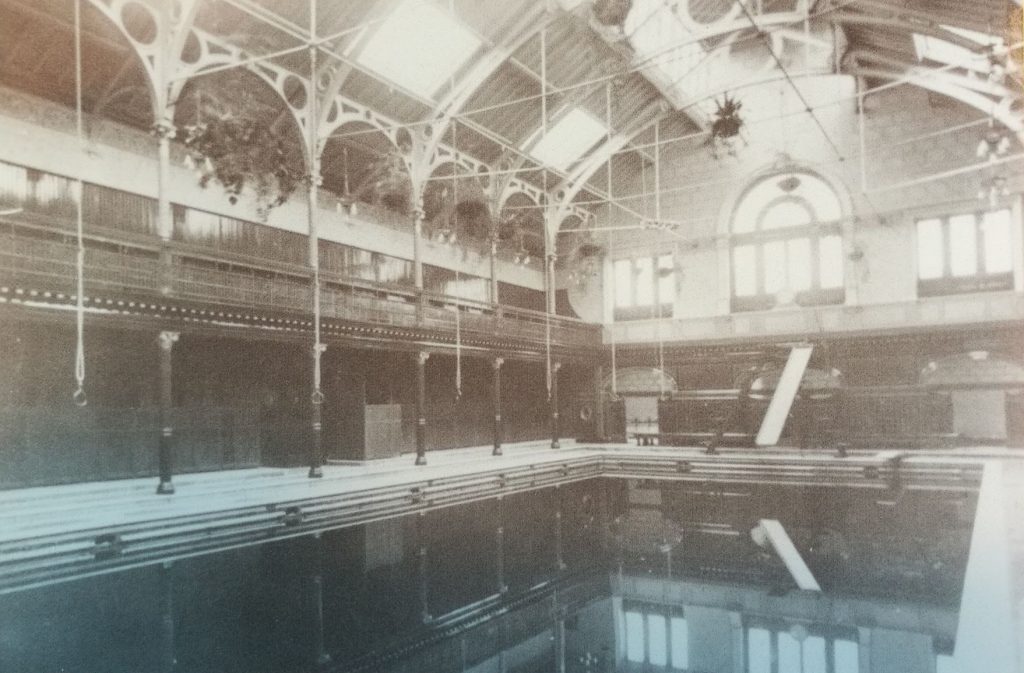
Dunfermline College, original building. Part of the Records of Dunfermline College of Physical Education (EUA IN16)
On this day (4th October) in 1905, the Carnegie Dunfermline Trust College of Hygiene and Physical Training (later renamed Dunfermline College of Physical Education) was founded. It was opened by the Marquis of Linlithgow (who was Secretary for Scotland) in the ‘palatial’ Carnegie Gymnasium in the presence of over 1,000 people. The ceremony was an important milestone in the history of the town of Dunfermline but also Scotland as a whole; this was the first college of physical education of its kind in the country.
Dunfermline had already been home to a number of health-focused amenities, thanks to funding from its native son, the Scottish-American industrialist and philanthropist Andrew Carnegie. There was ‘The Carnegie Gymnastics Club’ for young men and, later, a new gymnasium, swimming baths and Turkish Baths on Pilmuir Street.

The Carnegie Baths. Part of Records of Dunfermline College of Physical Education (EUA IN16)

Turkish Baths, Dunfermline. Part of the Records of Dunfermline College of Physical Education (EUA IN16)
The idea of public health and fitness was a growing concern following the publication of the Report of the Royal Commission on Physical Training (Scotland) a year earlier. With widespread poverty and malnutrition, cramped, urban lifestyles and a lack of physical education in schools, the fitness of the general population was found to be severely lacking. The Report effectively recommended compulsory physical education in schools to help combat this.
A syllabus of physical exercises was published for use in public elementary schools and the Carnegie Dunfermline Trustees provided male and female teachers to visit schools weekly and instruct children. However, there was a shortage of teachers specially trained in physical instruction and it was decided that a training college should be formed.
Miss Flora Ogston (daughter of Sir Alexander Ogston, Regius Professor of Surgery, University of Aberdeen from 1882 to 1909) became the first Principal of the College, which accepted women students only. Teaching at the College focused on theoretical and practical aspects of physical education, and included human anatomy and physiology, Ling’s Swedish system of gymnastics, remedial massage and, perhaps surprisingly, singing and voice production. The first 11 students to complete the two-year diploma course did so in 1907.

College Hockey Team, 1905-1906. Part of the Records of Dunfermline College of Physical Education (EUA IN16)
Giving a toast to the College at a dinner following the opening ceremony, Alexander Ogston concluded with his vision of what it represented in terms of national achievement and improved human wellbeing:
Scotland does not stand where it did; where formerly it was covered with what were quaintly termed “foul moors,” it is now so altered that it presents in their stead scenes of charming beauty and fertility, or is filled with the evidence of man’s industry and genius. It is not too much to expect that the agencies now active in the amelioration of the physical condition of its people, among which we hope the Dunfermline College will play a great part, will result in a somewhat similar elevation of all its inhabitants, in the production of a higher, nobler, better race, moving forwards towards perfection.
The records of Dunfermline College of Physical Education are currently being catalogued and we look forward to sharing more stories from the archive soon!
Sources:
- Addresses delivered on the occasion of the inauguration of the Carnegie Dunfermline Trust College of Hygiene and Physical Training on the 4th October 1905 (Dunfermline: A. Romanes & Son, 1905)
- Dr I.C. MacLean, The History of Dunfermline College of Physical Education (Edinburgh: Dunfermline College of Physical Education, 1976)
- www.victorianturkishbath.org
Clare Button
Project Archivist
